Stinging Insect Guide: Bees, Hornets, & Wasps in Davis County
By Thorn Team • Jul 28th 2021
It's common to fear stinging insects. Many of us have had negative experiences around bees, hornets, and wasps, and some of us who are allergic have good reason to avoid them at all costs.
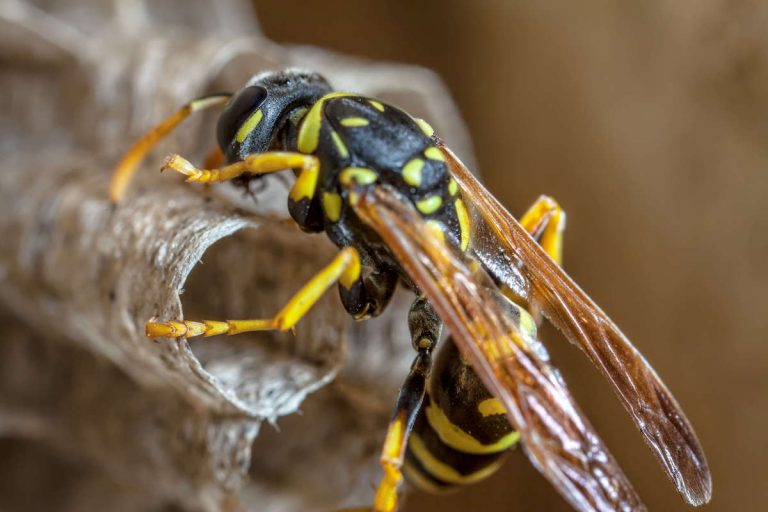
Many stinging insects are important pollinators, some rarely sting, while others are more aggressive and can be dangerous if they nest around your home. It's important to identify what stinging insects are around your home so you know when control is warranted.
We know that pollinators are an important part of creating a healthy and diverse ecosystem. At Thorn Pest Solutions Davis County, we believe in doing our part to protect bees and other pollinators.
In this article, we'll explore the various stinging insects common to Utah, and provide options for homeowners and businesses to learn how to manage these pests before they become a problem.
Common Stinging Insects in Davis County
The first step to maintaining a healthy balance of insects around your home or business is learning the difference between species of bees, wasps, hornets, and ants. While many people can recognize a bumblebee from a yellowjacket, there are a dizzying amount of different species in Utah. At least 900 native bee species inhabit The Beehive State.
Below, are the common stinging insects native to Utah:
- Paper Wasps
- Western Yellowjackets
- Mud Dauber Wasps
- Baldfaced Hornets
- Tarantula Hawk Wasps
- Pavement Ants
- Harvester Ants
- Blue Orchard Mason Bees
- Leafcutter Bees
- Sweat Bees
Utah Stinging Insect Identification
If you suspect a stinging insect problem in or around your home or business, the first step is identifying it. Use this guide to help you learn which species are common in Utah and what to look out for if you think you have an infestation.
There are two categories of wasps: social and solitary. The wasps that typically swarm around while you are trying to eat outside are social wasps. Solitary wasps aren't typically aggressive and rarely sting.
Social Wasps
There are three prominent types of social wasps in Utah, the common paper wasp, the western yellowjacket, and the baldfaced hornet.
Paper Wasps
Paper wasps are common members of the social wasp family, meaning they build colonies and have a queen similar to honey bees. Hornets and yellowjackets are also social wasps. There are four subspecies of paper wasps in Utah, but the most common is the western paper wasp, Mischocyttarus flavitarsus.
Color: They're dark brown, orange, or red, or can have yellow and black bands, which can often make people confuse them for yellowjackets.
Appearance: Paper wasps are easy to identify. They are more slender than yellowjackets and have long legs that seem to dangle when in flight. They appear to have a disjointed abdomen and usually appear hairless.
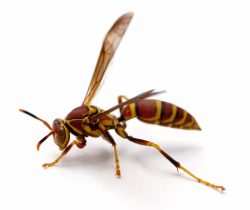
What to Look For: One of the most striking signs of a paper wasp infestation is the signature paper-like material nest they build. The nests are hollow, and are built annually by paper wasp queens, who will start new nests on a variety of structures or in small cavities such as trees, rocks, playground equipment, or on the eaves of buildings.
Control Methods: If you're keen to get rid of your paper wasp nest, the best time of day to spray it is at sunrise or dusk, when the wasps are least active. The best time to prevent nests is treating eaves, overhangs, and areas you know have had paper nests in the past in the spring. Overwintering queens will emerge and try to build nests in the spring and a little prevention in the spring will go a long way in preventing paper wasps all year.
Western Yellowjackets
Western yellowjackets are also social wasps. Yellowjackets often build their nest in holes in the ground but can also build enclosed aerial paper nests similar to those of baldfaced hornets. These are often found in the holes of trees. Yellow jackets can be very aggressive when their nest is approached and they pose a serious health risk to humans.
Color: Yellow and black.
Appearance: Yellowjackets are black and yellow and appear hairless. Their abdomen is more broad and blunt then paper wasps on the anterior side (the side of the abdomen closest to the thorax.
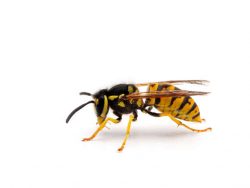
What to Look For: If you see large numbers of foraging yellowjackets, be on the lookout for nests. The most common time to find nests will be early summer through the fall. If you spot a nest or yellowjackets going in and out of a hole, do not go near!
Control Methods: Removing yellowjacket nests can be dangerous. It is best to call a professional to remove it. If you attempt to remove it on your own, use a bee veil, suit, and gloves and do not attempt while other people are present.
Baldfaced Hornets
Utah's most common hornet is the baldfaced hornet, which also falls under the category of social wasps. They often get mistaken for yellowjackets, as they look quite similar but yellowjackets are smaller. These hornets are quite docile, but like other social wasps, will sting if they feel threatened.
Color: Adult baldfaced hornets look very similar to yellowjackets they're smooth with black and yellow or white bands.
Appearance: The queen baldfaced hornet will be around three-quarters of an inch long, with the worker hornets usually about half an inch long.
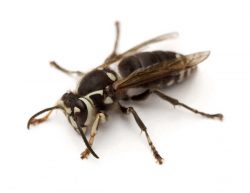
What to Look For: Like paper wasps, baldfaced hornets will build papery nests in trees or overhangs or under the roof eaves of buildings. They are very active during the summer months, and some nests can grow to be larger than a basketball, with a thick, multilayered outer shell.
You might also find hornets feasting on fallen fruit under trees; be vigilant about disposing of rotten fruit to help minimize hornets in the area. Hornets are prolific in Utah, and you can find them throughout the state. If you encounter a baldfaced hornet nest at your home, business, or school, we recommend calling a pest professional as they can be difficult/dangerous to remove.
Solitary Wasps
Mud Dauber Wasps
Unlike the social paper wasps, mud dauber are solitary wasps and do not live in colonies. Mud daubers are known for their construction of mud nests. They build several short mud tubes, usually about 1 inch long, side by side. Each mud tube is provisioned with several spiders that the female catches and paralyzes. She then deposits an egg on the spider and the mud dauber larvae will feed on the spider after it hatches.
Color: Usually black and may have pale markings or a metallic tinge.
Appearance: Appearance varies but they are typically up to 1 inch in length. The mud dauber has a long slender segment between the thorax and abdomen.
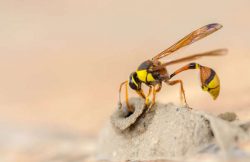
What to Look For: The most common sign of mud daubers are the nests. These nests are typically built in sheltered areas such as eaves, under window sills, in sheds, and under porches.
Control Methods: Mud daubers are not aggressive and are unlikely to sting. You should still remove their nests as more aggressive insects may take over the abandoned nest. Scrape the nest to remove it and then clean with soap and water.
Tarantula Hawk Wasps
The tarantula hawk wasp is named for its preferred meal: the tarantula. Although this wasp is found in Utah, it is not commonly a big pest problem around homes and structures. We included this wasp in this guide because it delivers a very painful sting. In fact the tarantula hawk wasp received a 4 on the Schmidt Pain Index, which is the highest rating on the scale. It delivers the most painful sting of any other stinging insect in Utah. The sting has been described as blinding, fierce, and shockingly electric.
Color: They're usually blackish blue with bright orange wings
Appearance: As the name suggests, these wasps are large, they can grow to be up to two inches long, making them appear very imposing if they enter your home or garden.
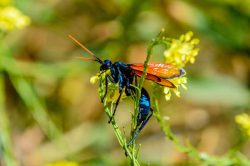
What to Look For: Tarantula hawk wasps are most active during the summer, but will often be dormant during the hottest part of the day. They prefer desert regions, and follow the food: If there are tarantulas nearby, these wasps will likely be on the trail.
Tarantula hawks don't build nests like paper wasps, rather, they burrow into the soil or use cavities left behind by other insects.
Ants
There are several pest ant species that are found in Utah, including pavement ants, harvester ants, odorous house ants, argentine ants, pharaoh ants, carpenter ants, field ants, and velvety tree ants. Some ants can sting and others cannot. In this guide we included the two most common ants found around structures in Utah that can sting.
Pavement Ants
Pavement ants are very common in Utah, often spotted in the cracks and crevices of city sidewalks. While they don't often sting, they occasionally deliver a mildly painful sting when they feel threatened.
Color They are small and black, and will feast upon nearly anything that comes across their paths.
What to Look For: You've probably come across pavement ant colonies if you live in a city. Pavement ants take refuge in sidewalks across the state, but are also known to make their homes in walls, insulation, or under floors in a home or business.
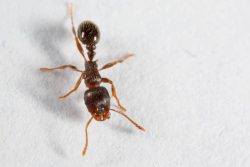
Harvester Ants
Harvester ants are known for decimating vegetation in urban areas, and can often be seen near bare soil. These ants should be avoided, as they can deliver a painful sting.
Color: Harvester ants are orange, red, or brown. They are on the larger side for ants, just a quarter to half an inch long.
What to Look For: These hungry ants are driven by areas of dense vegetation, and can often decimate your lawn. You can spot a harvester ant colony by looking for a small mound of dirt surrounded by bare patches of soil in prairie and grasslands.
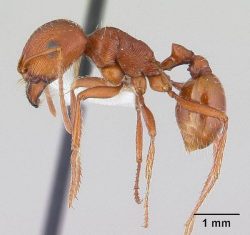
Bees
While bees tend to get a bad reputation, we know how important bees are to a thriving ecosystem. That said, no one wants a bee infestation in their home, and we understand the importance of finding a no-kill solution.
Blue Orchard Mason Bees
Blue orchard mason bees are common across the state. You can identify them by their bright metallic blue bodies.
Color: These bees are easy to spot by their bright blue bodies.
Appearance: They are similar in size to honeybees, and are highly effective pollinators, making them vital for agriculture.
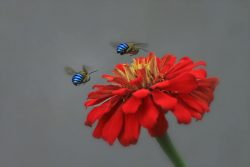
What to Look For: They carry pollen on their bellies and make their nests in holes, using clay to make partitions and seal the entrances to their nests. You'll most likely see blue orchard mason bees in early spring.
Leafcutter Bees
Leafcutters are another often-spotted species in Utah, and are more solitary bees who build their nests in small holes covered with chewed up leaves. Like orchard bees, leafcutters are vital participants on a healthy farm.
Color: Leafcutter bees are black and furry.
What to Look For: Leafcutters have a distinct method for building nests: Mothers will use chewed-up leaves to cover their nests. Leafcutters are most active in the spring months, and are primarily solitary bees.
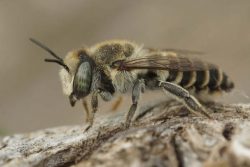
Sweat Bees
Sweat bees, also known as halictids, can also be found in Utah. They aren't aggressive, but are attracted to perspiration.
Color: These tiny bees are often black or brown, but you may find brightly colored sweat bees with metallic greens and blues.
What to Look For: Making their homes in the ground, sweat bees love the smell and taste of sweat, so you may find them (or vice versa) when you're exercising outdoors in the springtime.
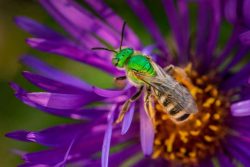
Stinging Insect Infestations
Dealing with a stinging insect infestation takes time and patience. The first step is identifying what type of insect is in your home or business, which can often be best done by a professional pest control worker from Thorn. However, prevention is always a vital component of pest control.
Bees are often drawn to fresh flowers, and should be considered a welcome guest in your garden. They are often docile, and will only sting if provoked. These beneficial insects are attracted to anything sweet, so unattended soda cans or fruit can often bring a bee to your picnic table.
Wasps and hornets will also be attracted to sweet items or unattended food, so be sure to keep an eye on your plate if you're dining outside. Both are drawn to food or garbage, making it important to keep a lid on your garbage can if it's outdoors.
Ants will go searching for water and food. Areas of standing water or garbage can be a welcome habitat for stinging ants.
If you're seeing an abundance of wasps, hornets, or ants, it's a good idea to check for signs that they've burrowed or built a nest. If you see signs of nesting, there's a chance they've found a great habitat with an abundance of food. Thorn can help you identify these areas of your home and help eliminate the issue before it becomes problematic for your house or business.
Utah Insect Sting Health & Safety
Getting stung by an insect isn't fun. But most stings will create minor reactions that are easy to manage at home. That said, it's important to know which insects can cause potentially more dangerous reactions than others.
Treating a wasp or hornet sting
You'll know it if a wasp or hornet stings you. These stings can be quite painful, and almost everyone experiences some swelling and itching. Those who are allergic to wasps should always seek medical attention. But for others, a simple antihistamine and a few steps will help you heal quickly.
Wasp and hornet stings should be washed with soap and water to remove as much of the venom as possible, and application of a cold pack can reduce swelling and pain. Keep the sting area clean and dry to prevent infection.
What's important to know about wasps and hornets is that they retain their stinger, meaning they can sting multiple times. An angry hornet may be inclined to sting again, so be sure to leave the area after an initial sting.
What to know about ant stings
Most ant stings are uneventful; while they may hurt at first, there are few long-term consequences to ant stings. Ant stings usually don't swell as much as wasp or hornet stings, unless you're prone to allergic reactions. The important thing is to keep an eye on where you were stung, and seek medical attention if you experience shortness of breath.
Stinging Insect Infestation Prevention Tips & Tricks
As mentioned above, prevention is the best method for dealing with stinging insects. There are many easy steps you can take to keep these insects out of your home or business.
- Garbage cans, and compost bins should remain covered, and fruit from trees should be collected as quickly as possible to avoid rotting. Eliminating food sources or rotting food in trash cans is a great prevention method for any stinging insect.
- Install tight-fitting screens in windows and seal any exterior cracks, crevices, or holes where stinging insects could make their home. These holes are common around where pipes and utility lines enter buildings.
- Flowers in your gardens are often pollination hot spots for bees. As long as the bees are unprovoked, they can continue to be the excellent pollinators they are.
Thorn Pest Solutions Davis County is here to help. We offer thorough inspections and action plans to help rid your home and property of stinging insects. Contact our team of friendly scientists to find out about our ant control services and wasp control services in Davis County.
About Thorn
Thorn is a Utah local pest management company. We are a QualityPro certified company which is a prestigious accreditation awarded to less than 3% of the pest management companies in the US.
Resources
About Thorn
Thorn is a Utah local pest management company. We are a QualityPro certified company which is a prestigious accreditation awarded to less than 3% of the pest management companies in the US.